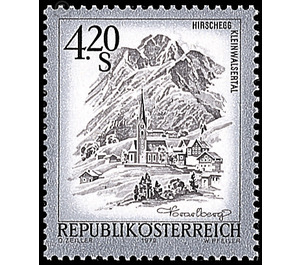landscapes - Austria / II. Republic of Austria 1979 - 4.20 Shilling
Theme: Geology & Geography
| Country | Austria / II. Republic of Austria |
| Issue Date | 1979 |
| Face Value | 4.20 |
| Color | grey |
| Printing Type | combination printing |
| Stamp Type | Definitive |
| Item Type | Stamp |
| Chronological Issue Number | 955 |
| Chronological Chapter | OOS-OE2 |
| SID | 973127 |
| In 72 Wishlists | |
In the northeast of the Austrian province Vorarlberg lies the valley of the Breitach, the Kleinwalsertal. The Breitach flows along the three parishes Mittelberg, Hirschegg and Riezlern. These have always been the political community Mittelberg. Due to the progressive erosion over many hundreds of thousands of years, the waters of the Breitach have dug deep into the rocky ground. The result is the Breitachklamm, one of the mightiest natural wonders in southern Germany. The first settlers of the Kleinwalsertal were Walser from today's Canton Valais in Switzerland. Until 1453, the counts of Rettenberg and the brothers of Heimenhofen (Allgäu) were the landlords of the Tannberg and the Breitachtales. In 1453, the Duke of Innsbruck conquered the valley, and so it came to Austria. For many centuries, especially agriculture and alpine farming were the livelihoods of the Kleinwalsertal. The removal of tariff barriers and favorable transport links with Germany paved the way for tourism as a new mode of employment. Thus, the influx of recreation seekers and ski vacationers increased enormously and today forms an essential basis of the economic development of the Kleinwalsertal.


